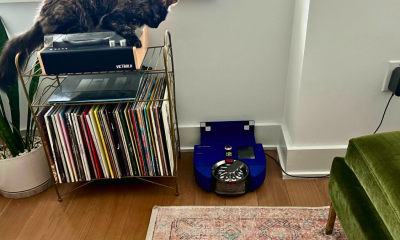Entertainment
This 18th century prison design predicted the rise of our surveillance society

This article provides additional details and context for Episode 2 of Mashable’s new podcast, Fiction Predictions. Listen here.
We think about surveillance – from big tech and governments using gadgets to snoop on individuals to CCTV cameras – as a contemporary phenomenon.
It’s not.
In fact, surveillance – and the knowledge that because we are being watched we should act a certain way – is one of the foundations upon which the modern world was built. And it all started with an 18th century prison design, popularised as a metaphor for our surveillance society by French philosopher Michel Foucault.
That old prison concept has deeply infiltrated popular culture in various guises. For example, let’s take the prison where the main characters in The Guardians of the Galaxy all meet.
The Kyln prison, where Star Lord, Rocket Raccoon, Groot, and Gamora are taken to be processed, is based on a simple architectural idea – a central watchtower with a 360-degree view of all cells along the circumference of the prison.
The prison
The architecture for the prison was first designed by a philosopher called Jeremy Bentham. Its design is known as the panopticon. The way it works is inscribed in the name. It allows all (pan-) inmates of an institution to be observed (-opticon).

Drawing of the panopticon from Bentham’s book ‘Management of the Poor.’
Image: The LIFE Picture Collection/Gett
Here’s how Bentham figured the panopticon would work: it would consist of a central tower surrounded by cells, just like in Guardians. This tower houses watchpeople. The cells: prisoners. (Or workers, children, patients – all depending on the functional use of the architecture.) But the cell cannot see into the watchtower; the occupants are perpetually unaware whether, if, or when, they are being observed.
It’s a simple, but undeniably thought-provoking idea. You act differently, according to the socially constructed etiquette of the physical place you find yourself in – bank, workplace, bedroom, library, bathroom, etc. But, it’s especially important in the case of the prison because, within the panopticon, you don’t even need guards. All you need is a watchtower that the prisoners assume contains watchful eyes.
Another great adaption of the panopticon experiment is Oz: the popular TV series about an experimental wing of a prison – nicknamed “Emerald City” – in which all the cells are see-through.
Foucault’s Philosophy
Bentham was a brilliant philosopher and an influential individual during his lifetime. But, despite dedicating almost 20 years of his life to making the panopticon an institution for the masses, it never caught on. So his prison was forgotten until another philosopher dusted the old Bentham books from the shelves and wrote a sort of genealogy of modern power around the concept of the panopticon. And that’s Michel Foucault.
Foucault was one of the most important philosophers to dedicate themselves to tracing a sort of history of the present — of how human beings today have come to be the way we are. In that endeavour, Foucault showed how the past continues to flow through the present, and how it affects the future.

Portrait of French philosopher Michel Foucault in Paris, France in February 1977.
Image: Nikolay nikolov/Getty
Foucault brought back Bentham’s panopticon and used the design as a metaphor for society at large – a system of insiders (good) and outsiders (bad). A society of order, discipline, and laws. A society of knowledge and information about every individual participating in it. In a 1975 book called Discipline and Punish, Foucault illustrates how modern societies are based on creating normalised behaviour, where people police themselves to act in a certain way.
To quote Foucault: “Bentham laid down the principle that power should be visible and unverifiable. Visible: the inmate will constantly have before his eyes the tall outline of the central tower from which he is spied upon. Unverifiable: the inmate must never know whether he is being looked at at any one moment; but he must be sure that he may always be so.“
Now, 50 years on from when Foucault brought back the panopticon, its power seems even more prescient today.
The eye
Our contemporary society is one giant panopticon – from CCTV cameras to more extreme cases, like the NSA spying on millions of people and China’s social credit system, which will digitally rate people according to their behaviour.

Panopticon.
Image: nikolay nikolov/Getty
CCTV cameras are the most obvious analogy, with cities like London defending the wide-ranging use of surveillance cameras as an effective crime-reduction tool. In fact, the English capital is one of the most widely-watched cities in the world. As someone who lives in this city it could not be more striking, as every building corner feels like it’s ornamented with artificial eyes.
From cell phones spying on us to Alexas in our homes recording every word we utter to them, and Google mapping our every move and online query, the world has never felt smaller – and we never this aware that we are being watched.

A row of closed circuit television (CCTV) surveillance cameras in Tiananmen Square, Beijing, China.
Image: Corbis via Getty Images
The knowledge that any digital trace can come back to haunt you can force people to anxiously self-discipline themselves – and not just in public, but in private. This is the ultimate dream of the panopticon. We live in a world where a social media post from a number of years back can affect your career, land you in prison, and ruin your life. Nowadays, kids growing up in this social media era are learning to clean up their digital selves before heading to interviews. It’s a new system of self-censorship and self-discipline in a world where everything about you is accessible.
The Tower
Technology is all-powerful, sure, and perhaps the most ubiquitous application of the panopticon system. But let’s take a step back. A final one. As Bentham said, the panopticon is an architecture, and while Foucault expanded upon that to include all structures that inspire self-discipline, it’s important to consider the centrality of architecture because once you think about it – it’s everywhere.
And it’s the centrality of towers, in particular, that is particularly striking when thinking about the power of architecture over cityscapes. From the Eye of Sauron to pretty much every single high-rise building constructed by totalitarian regimes, towers — in both fiction and in life — are central sites of power that are intended to transform cityscapes and incessantly remind people about the context of their surroundings.
Tolkien apparently took inspiration for the Eye after visiting the University of Birmingham, which has the tallest freestanding clock tower in the world. It can be seen from pretty much everywhere in the city. In LoTR, the Eye is the perfect panopticon metaphor, embodying the quality of the all-seeing watchtower. The more you think about it, the more towers there are that play central roles in famous fiction – take Stephen King’s The Dark Tower, for instance.
In the real world, one of the most fertile grounds for all-seeing towers was the former Soviet Bloc. When Joseph Stalin usurped power in the Soviet Union, he placed great importance on the role of architecture, embarking on grandiose projects to erect what were at the time the highest buildings in Europe. Today, they are known as the “Seven Sisters” towers in Moscow. Each was intended as a physical testament to the resilience and power of communism, a sign of the future, and a negation of the non-communist imperial past.
The same is true for the socialist satellites in Eastern Europe. There, Stalinist skyscrapers, behemoths and monuments were built to dominate the surrounding cityscape, to change the course of history and recenter the site of power. Examples of this include the Palace of Culture and Science in Warsaw — a Soviet gift of fantastical proportions that continues to entirely and fully dominate the Polish capital. Naturally, the Palace can be seen from everywhere and by everyone, a symbol of a regime that capitulated nearly 30 years ago. But the palace holds on, in the centre, reminding people of what once was the norm.

Тhe Palace of Culture, towering above the skyline.
Image: LightRocket via Getty Images
Ultimately, the panopticon (as architecture) and the panopticon (as a system of power) has nearly universal applications. Which means that this is where this article stops, leaving you with one final thought. What we haven’t discussed, and perhaps, what is almost impossible to figure out, is this: if we know there are those that watch and those that are being watched, is there anyone, then, tasked with watching the watchpeople? We see it happening everywhere – huge companies, like Facebook, which over a billion people have trusted with sensitive information, admit to hacks, breaches, password leaks, etc.
Who watches over them when no-one is looking? And as we continue to learn how technology is utilised to surveil and spy on individuals, it will be up to government regulators (take GDPR by the EU as an example) and individuals (like whistleblowers and journalists) to try and shine light back in on the dark watchtowers of modern-day panopticons.
-

 Business4 days ago
Business4 days agoAPI startup Noname Security nears $500M deal to sell itself to Akamai
-

 Business6 days ago
Business6 days agoYoshi Mobility has come a long way since gassing up cars on the side of the road
-

 Entertainment4 days ago
Entertainment4 days agoHow to watch ‘Argylle’: When and where is it streaming?
-

 Entertainment3 days ago
Entertainment3 days agoNASA discovered bacteria that wouldn’t die. Now it’s boosting sunscreen.
-

 Business4 days ago
Business4 days agoUS think tank Heritage Foundation hit by cyberattack
-

 Entertainment3 days ago
Entertainment3 days agoDyson 360 Vis Nav robot vacuum review: Dyson should just stick to upright vacuums
-

 Business3 days ago
Business3 days agoTesla drops prices, Meta confirms Llama 3 release, and Apple allows emulators in the App Store
-

 Entertainment4 days ago
Entertainment4 days agoCrypto and taxes: Which forms you need to file



















